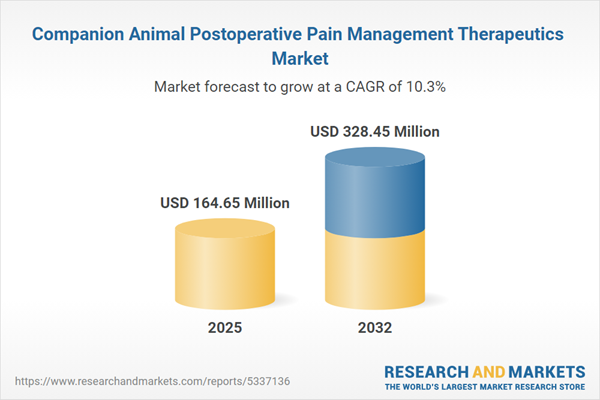Speak directly to the analyst to clarify any post sales queries you may have.
The companion animal postoperative pain management therapeutics market is undergoing swift transformation, shaped by technological breakthroughs and increasing expectations among veterinary professionals and pet owners. Advanced delivery mechanisms, enhanced product segmentation, and expanding regional adoption form a competitive environment that demands careful strategic planning.
Market Snapshot: Growth Trajectory and Industry Drivers
The Companion Animal Postoperative Pain Management Therapeutics Market grew from USD 149.46 million in 2024 to USD 164.65 million in 2025. It is expected to continue growing at a CAGR of 10.34%, reaching USD 328.45 million by 2032.
Momentum in this sector is sustained by heightened awareness of animal welfare, ongoing investment in veterinary therapeutics innovation, and the broader application of digital health solutions for post-surgical recovery. Pharmaceutical companies are responding with next-generation analgesics and scalable delivery models that align with both clinical and commercial priorities. Adaptation to shifting regulatory requirements and heightened emphasis on environmental sustainability are also contributing to market evolution.
Scope & Segmentation: Precision Therapeutics and Global Reach
- Product Types: Local anesthetics (such as bupivacaine, lidocaine); non-steroidal anti-inflammatory drugs (including carprofen, deracoxib, firocoxib, meloxicam); opioids (including buprenorphine, fentanyl, tramadol).
- Animal Types: Cats, dogs.
- Routes of Administration: Injectable, oral, topical, transdermal patch.
- End Users: Online pharmacies, veterinary hospitals and clinics (general practices, specialty hospitals), veterinary retail pharmacies (chain and independent)
- Geographical Coverage: Americas (North America including United States, Canada, Mexico; Latin America including Brazil, Argentina, Chile, Colombia, Peru), Europe, Middle East & Africa (Europe, Middle East, Africa), Asia-Pacific (China, India, Japan, Australia, South Korea, Indonesia, Thailand, Malaysia, Singapore, Taiwan)
- Leading Companies: Zoetis Inc., Elanco Animal Health Incorporated, Merck & Co., Inc., Boehringer Ingelheim International GmbH, Dechra Pharmaceuticals PLC, Norbrook Laboratories Ltd., Vetoquinol SA, Ceva Santé Animale SA, Virbac SA, Johnson & Johnson Services, Inc.
Technologies spanning liposomal carriers, nanoparticle suspensions, and extended-release matrices broaden delivery options and enable improved therapeutic precision.
Key Takeaways for Senior Decision-Makers
- The rising expectation for rapid-acting, long-duration pain relief therapies is shaping R&D pipelines and clinical protocols alike.
- Innovation in analgesic formulation and digital monitoring is fueling integration of pharmacological and data-driven post-surgical care programs.
- Regulatory frameworks are adapting, with authorities enabling faster review and approval, particularly for novel pain management modalities backed by robust safety data.
- Supply chain sustainability is coming into sharper focus as companies invest in eco-conscious packaging and bolster domestic manufacturing in response to market disruptions.
- Strategic collaborations among manufacturers, research organizations, and veterinary networks are accelerating bench-to-clinic transitions and supporting expansion into new segments and markets.
Tariff Impact: Navigating New Cost Structures and Sourcing Models
Recent tariff adjustments within the United States are reshaping import strategies for active pharmaceutical ingredients and excipients. Manufacturers are pursuing alternative sourcing, renegotiating supplier contracts, and establishing domestic manufacturing capacities to optimize logistics and offset new cost pressures. The evolving tariff environment requires agile regulatory advocacy and proactive adjustment of investment priorities to ensure uninterrupted supply of essential pain therapeutics.
Methodology & Data Sources
This report relies on a comprehensive methodology, integrating secondary research drawn from scientific literature, industry reports, and regulatory documents. In-depth interviews with veterinary surgeons, regulatory specialists, and executives provided real-world perspectives. Quantitative models utilized proprietary databases and triangulation from multiple market intelligence sources to validate research findings and ensure robust segment analysis.
Why This Report Matters
- Enables stakeholders to identify growth opportunities across segmented product, end user, and regional value chains in companion animal postoperative pain management therapeutics.
- Supports confident decision-making for investment, portfolio expansion, and supply resilience by offering actionable insights on technology uptake and evolving regulatory frameworks.
- Facilitates strategy development for navigating region-specific challenges, from regulatory compliance to market access and supply chain sustainability.
Conclusion
The companion animal postoperative pain management therapeutics sector is defined by scientific innovation, adaptive strategies, and collaborative advancement. Informed, agile decision-making will be key for industry leaders navigating this evolving market landscape.
Additional Product Information:
- Purchase of this report includes 1 year online access with quarterly updates.
- This report can be updated on request. Please contact our Customer Experience team using the Ask a Question widget on our website.
Table of Contents
3. Executive Summary
4. Market Overview
7. Cumulative Impact of Artificial Intelligence 2025
Companies Mentioned
The companies profiled in this Companion Animal Postoperative Pain Management Therapeutics market report include:- Zoetis Inc.
- Elanco Animal Health Incorporated
- Merck & Co., Inc.
- Boehringer Ingelheim International GmbH
- Dechra Pharmaceuticals PLC
- Norbrook Laboratories Ltd.
- Vetoquinol SA
- Ceva Santé Animale SA
- Virbac SA
- Johnson & Johnson Services, Inc.
Table Information
| Report Attribute | Details |
|---|---|
| No. of Pages | 197 |
| Published | October 2025 |
| Forecast Period | 2025 - 2032 |
| Estimated Market Value ( USD | $ 164.65 Million |
| Forecasted Market Value ( USD | $ 328.45 Million |
| Compound Annual Growth Rate | 10.3% |
| Regions Covered | Global |
| No. of Companies Mentioned | 10 |









